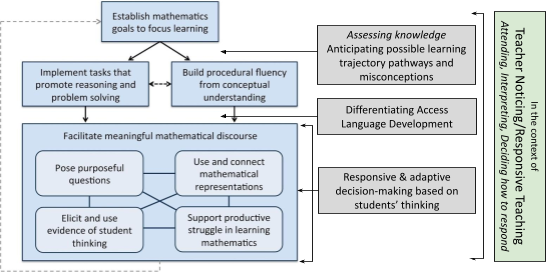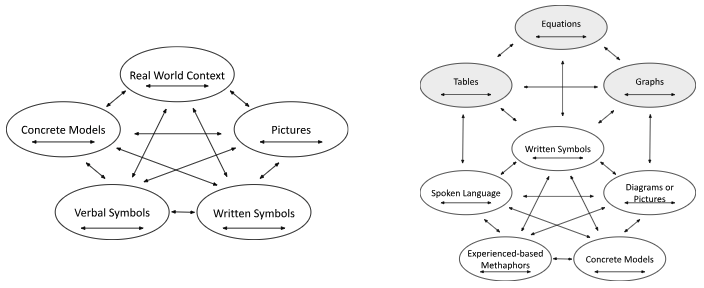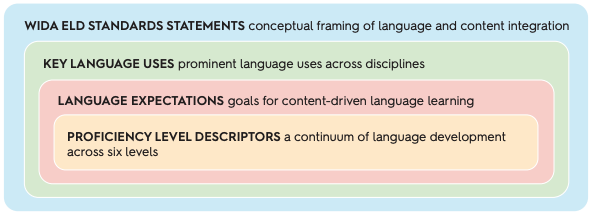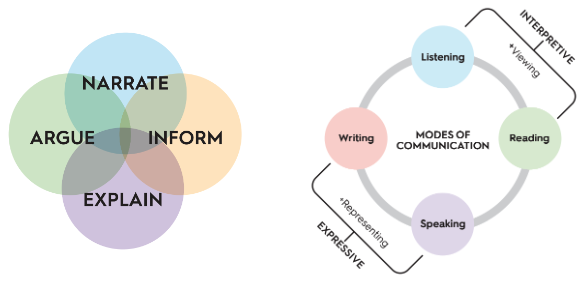Cluster Three: Language Development (Access & equity)
Return to the Mathematical Practices Overview Page
A Professional Development Approach
- Developing the classroom norms and conversational skills sets for students to communicate their ideas. (MP3: Construct viable arguments and critique the reasoning of others)
- Language objectives for mathematics lessons
- Oral language development - Developing Student Voice
- Active listening skill development
- Academic Language Development: Content vocabulary, language functions, grammar syntax
- A definition through a culturally sustainable lens
- For all students
- For Multilingual Learners/English Language Learners
- Scaffolding to create access to content
- Mathematical Language Routines
- Visuals
- Sentence frames, starters, and kernels & The Writing Revolution
|
Thought is not merely expressed in words; it comes into existence through them. Every thought tends to connect something with something else, to establish a relation between things. (Vygotsky, 1934, p. 218) |
Introduction
Mathematics is socially constructed. Solutions and proof are based on the consensus of the underlying mathematical structures. Like math, language acquisition is also socially constructed. Thus, mathematics is inherently language based. Planning for and supporting students to develop their mathematical voice is a matter of empowerment as it grants access to a community that otherwise remains closed. Language shapes the discourse environment and empowers students (and teachers) to articulate and convey their thinking. Without language, access to learning is limited. To achieve a learning environment that is inclusive of both all students as well as the particular needs of a multilingual learner’s math and language needs, we must establish a sense of safety. The classroom norms establishing the emotional and intellectual sense of safety need to be cultivated within any learning community. It’s also valuable to highlight that many of the instructional practices defined and described support the learning of all learners.
Defining Language Learners
All students in your classroom are language learners whether or not they are native English or speakers of another language. To construct viable arguments and critique the reasoning of others (Standard for Mathematical Practice 3 [MP3]) requires all students to develop the skill set of being active listeners, interpreters, and constructive critics of their own work and that of their peers. In order to facilitate meaningful mathematical discourse, pose purposeful questions, and elicit and use student thinking (Mathematical Practices 4, 5 & 8) language skills need to be nurtured within the learning environment. This is essential regardless of whether multilingual learners are present within that learning space. Mathematics teachers are language teachers as well as mathematical content teachers.
|
Students need repeated, strategic, iterative and supported opportunities to articulate complex mathematical ideas into words, sentences, and paragraphs (Mondada, 2004). They need spiraled practice in (a) making their ideas stronger with more robust reasoning and examples, and (b) making their ideas clearer with more precise language and visuals. They need to make claims, justify claims with evidence, make conjectures, communicate their reasoning, critique the reasoning of others, and engage in other mathematical practices. Increasing the quality and quantity of opportunities to describe mathematical reasoning also will allow teachers to frequently formatively assess students’ content learning and language use so that teachers can provide feedback and differentiate instruction more effectively. (Zwiers, et al., 2017, p.7) |
Defining Multilingual Learner
Finding the spoken or written words to create an understanding of a specific group of students can be challenging. Currently, the term English Learner (EL) is commonly used across the United States to identify students who meet state and federal criteria for English language services. This legal term has come under some scrutiny as it limits our understanding of who this population of students are and doesn’t account for the many assets they bring to the learning environment.. These students are learning, whether officially or not, in at least two languages as they navigate home and school. In an effort to acknowledge the range of educational, cultural, linguistic, and lived experiences of our students, the term Multilingual Learner has emerged. Although the federal and local state governments have maintained the term English Learner as a legal designation for reporting purposes, many teachers and administrators have moved to using the term Multilingual Learner, or ML for short, for the reasons stated above. ML may be used when referring to the parents/guardians of MLs and teachers that provide English language development services. For the purposes of this website, we will use ML and EL interchangeably to reference students who require English language services.
Defining Academic Language
The definition of academic language that this project uses takes a culturally sustainable lens. We define this term as;
|
Academic language, at its core, is the language students need to organize and convey their thinking to the audience with whom they are interacting. Access and acceptance within a specific community vary and a lack of understanding of a community’s language patterns can be used to exclude participation within that community. Assisting students to gain the perspective and skill set of understanding the societal language patterns of different communities is to enable them to gain entry to a wider range of societal circles of power and therefore position themselves to affect change. We acknowledge the tension between preparing teachers and their students for the language demands of academic and professional work while also respecting and honoring varying linguistic identities – J. Brickwedde & P Egan |
Supporting the learning of academic language is essential for all students because it is not an inherently natural method of communication and contains much technically precise vocabulary. Students designated as Multilingual/English Learners benefit tremendously from explicit and engaging lessons at the word and sentence level as do native English speakers.
Building Student Voice & Active Listening Skills
Mathematical Practices Three (MP3) seeks to have students construct viable arguments and critique the reasoning of others. To do so requires a language skill set that moves beyond just knowing and using the technical vocabulary of the domain. It requires the command of the organization of one’s thoughts and the ability to sequence and convey those thoughts in an articulate fashion. A core feature of classrooms that utilize these practices is that you hear students describing, explaining, collaborating, and sharing. In other words, there is a lot of talking. For those conversations to be purposeful and productive, students have to develop a skill set allowing them to develop their own voice, have the capacity to actively listen to others, and to comprehend the perspective of another as that individual’s point of view is considered. As the instructional leader in the classroom, it requires developing those discourse practices and the community of practice in which students feel emotionally and intellectually safe in communicating ideas. (Brickwedde, 2022)
Planning for Language Objectives in the Mathematics Classroom
To associate language objectives in the planning of a math lesson seems a non sequitur. Yet to develop the skill set to construct viable arguments and critique the reasoning of others, as well as the related mathematical practices associated with facilitating classroom discourse, the planning of the lesson needs to include the development of at least oral language objectives if not eventually to convey one’s thoughts in writing. Not only do the technical vocabulary and notation systems need to be nurtured, but the syntax and grammar structures of the language of various communities of power need to be understood. How one conveys mathematical ideas at a neighborhood community meeting is quite different than how one presents before an academic mathematics or education conference. Additionally, conveying mathematical ideas requires a deeper understanding of how syntax and grammar functions in mathematical settings as opposed to other academic settings. Figure one below reminds us that explicitly planning for the language development of all the learners within the learning community is critical. One cannot assume that the language skills are inherent to even native speakers. Planning for explicit instruction if one has multilingual students within the community is even more essential.

Figure One: A System of Practice, System of Instruction (Hiebert, et al. 1997), Mathematics Teaching Framework (NCTM, Taking Action Series, 2017), Teacher Noticing Skills/Responsive Teaching (Jacobs, et al., 2010, Richards & Robertson, 2016)
Oral Language Development
As described in Cluster Two: Instruction - Use and Connect Representations, the Lesh Translation model captures how different neurological interactions are activated as one works across modalities. Vygotsky states how thought is language. As one moves across modalities language is used to articulate those thoughts. Blending those two models with the WIDA Consortium’s most recent K-12 English language development standards framework (2020) helps capture how planning and supporting the development of language for all students in the learning environment occurs. WIDA’s framework articulates the support multilingual learners need to advance in developing fluency in the English language. Its’ work captures the language development process that is useful in building language rich mathematical classrooms.

Figure Two" Lesh Translation Model
Left model, Lesh 1979; Right model, Kaput, 1987; Lesh & Dorrer, 2003
The English Language Development Standards are built around key language uses, expectations, and proficiency levels (WIDA, 2020. pp. 26-33).

Figure 3: The Components of the WIDA ELD Standards Framework, WIDA English language development standards framework, 2020 edition Board of Regents of the University of Wisconsin System, p.23
The key language uses are narrate (to convey real or imaginary experiences), inform (language to convey factual information), explain (language to give an account of why things work or how things happened), and argue (language to justify claims using evidence and reasoning) (WIDA, 2020. pp.26-27). Language expectations include communication modes (interpretative: listening, reading, viewing; expressive: speaking, writing, and representing) and language functions (common patterns of language use) and features (types of sentences, clauses, phrases, and words)

Figures 4 & 5: Key language Uses (Left) and Modes of Communication (Right)
WIDA English language development standards framework, 2020 edition
Board of Regents of the University of Wisconsin System, pp. 26 & 29
Language Use is broken down into three dimensions shaped by the sociocultural context within which language occurs. These dimensions occur at the word/phrase level, sentence level, and “discourse”* ML level. Language use changes as one moves across everyday language (language for representing ideas in nontechnical ways), cross-disciplinary language (common academic language used across content area contexts), and technical language (specialized language associated, in this case, specifically with mathematics). Assisting students in building the capacity to move across these uses of language is essential for accessing communities of power that they would otherwise be closed off to.
*A sidebar: The quote below highlights that each profession – mathematics education and multilingual education – have their own expertise and vocabulary. The term discourse carries two different meanings between the two fields. Multilingual educators use discourse in a more targeted manner to capture how a language user constructs a meaningful message supported by the sentence and word/phrase dimensions. The organization of the individual’s ideas are analyzed as to its cohesion and density, how loosely or tightly the language is packed. The focus is on the individual user. Mathematics education, along with science, literacy, and social studies fields, use discourse to describe the dynamics of communication between and among the members of the learning community. It is inclusive of the individual learner, but more broadly captures how individuals are communicating within the context of the whole classroom, where authority lies, and the identities individuals take on within that learning space. It can be confusing when working with a colleague when terms don’t neatly align. Just be clear with each other how each of you are using the term.
|
Language development is its own field of expertise, just as each discipline is. As content and language teachers dive deeper into standards-based planning and delivery of instruction, language specialists can help content teachers learn more about Language Functions and Features. Similarly, content teachers can help language specialists connect to content learning. WIDA English Language Development Standards Framework, 2020 Edition, p. 30 |
Proficiency Level Descriptors describe how multilingual learners use language toward the end of each language proficiency level. While the proficiency levels are presented sequentially as PL1 through PL6, it is important to know that students can operate at more than one level. They may speak at one level but write at a different level. To adapt a quote from math education researcher Michael Battista, one should assess “levels of reasoning (usage), not levels of students” (Battista, 2012, p.47). Page 34 of the WIDA document speaks directly to this point in that multilingual students should not be restricted from using complex texts or grade-level materials that limit their ability to participate in meaningful conversations within the classroom.
Grade level cluster materials within the larger WIDA document begin with kindergarten and proceed from there. The Table of Contents allows you to go directly to the grade level band that you wish to review. Standard 3 is specific to mathematics. One can also access specific grade level band information and materials (across all subjects) through a separate access point on the WIDA website.
Direct links to grade level Standard Three: Language for Mathematics
Kindergarten
Social & Instructional Language – Language for Mathematics – Proficiency Descriptors
First Grade
Social & Instructional Language – Language for Mathematics – Proficiency Descriptors
Grades 2-3
Social & Instructional Language – Language for Mathematics – Proficiency Descriptors
Grades 4-5
Social & Instructional Language – Language for Mathematics – Proficiency Descriptors
Grades 6-8
Social & Instructional Language – Language for Mathematics – Proficiency Descriptors
Grades 9-12
Social & Instructional Language – Language for Mathematics – Proficiency Descriptors
Supportive Oral, Graphical, and Written Language Practices
A collaborative team of researchers from Stanford University (Zwiers, et al., 2017) presented a set of principles and routines that support mathematical learners’ disciplinary language learning. The intent is to make language development an integral part of planning and delivering instruction. The design principles are:
- Support sense-making – Scaffold tasks and amplify language so students can make their own meaning.
- Optimize output – Strengthen the opportunities and supports for helping students to describe clearly their mathematical thing to other, orally, visually, and in writing
- Cultivate conversation – Strengthen the opportunities and supports for constructive mathematical conversations (pairs, groups, and whole class).
- Maximize linguistic and cognitive meta-awareness – Strengthen the “meta-” connections and distinctions between mathematical ideas, reasoning, and language.
Zwiers and his colleagues elaborate eight Mathematical Language Routines that are most effective and practical for simultaneously learning mathematical practices, content, and language. Details about what each routine develops and examples of how implementation can look like is found in the body of the 2017 open source document.
Mathematical Language Routine 1: Stronger and Clearer Each Time – To provide a structured and interactive opportunity for students to revise and refine both their ideas and their verbal and written output. (Zwiers, 2014)
Mathematical Language Routine 2: Collect and Display – To capture students’ oral words and phrases into a stable, collective reference.
Mathematical Language Routine 3: Critique, Correct, and Clarify – To give students a piece of mathematical writing that is not their own to analyze, reflect on, and develop.
Mathematical Language Routine 4: Information Gap – To create a need to students to communicate
Mathematical Language Routine 5: Co-Craft Questions and Problems – To allow students to get inside of a context before feeling pressure to produce answers, to create space for students to produce the language of mathematical questions themselves, and to provide opportunities for students to analyze how different mathematical forms can represent different situations.
Mathematical Language Routine 6: Three Reads – To ensure that students know what they are being asked to do. Create opportunities for students to reflect on the ways mathematical questions are presented, and equip students with tools used to negotiate meaning.
Mathematical Language Routine 7: Compare and Connect – To foster students; meta-awareness as the identify, compare, and contrast different mathematical approaches, representations, concepts, examples, and language.
Mathematical Language Routine 8: Discussion Supports – To support rich and inclusive discussions about mathematical ideas, representation, contexts, and strategies.
These routines provide a clear vision as to how and why K-12 mathematics teachers are language teachers. This is true whether or not multilingual learners are present in the classroom. However, these routines are especially important for multilingual learners in that it provides the spaces for the language to be thought through, practiced in smaller partner or group settings (including allowing for translanguaging opportunities for peers), before larger group public sharing takes place. Attention to such routines needs to be planned and intentionally incorporated into daily lessons.
Physical Space
The ability to facilitate a language-rich discourse environment is influenced by the physical arrangement of the classroom space. This is as important as the language routines themselves. Read more about ways to think about how physical space can be thought through.
Resources
Books
- SIOP for Teaching Mathematics to English Learners
- Teaching Math to English Learners
- The ELL Teacher’s Toolbox: Hundreds of Practical Ideas to Support Your Students
- EL Excellence Everyday
- Unlocking English Learner’s Potential: Strategies for Making Content Accessible
- 2020 WIDA Standards Book
- Jeffrey Zwiers - Academic Conversations K-3 guide
- Talk Read Talk Write
Articles
- Translanguaging
- Math Instruction for English Language Learners
- 4 Strategies to Help English Learners Master New Math Skills
- Math Language Routines: Discourse with a Purpose
Videos
- Translanguaging
- Carly Payne: A Fifth Grade Volume Lesson (Video link is at the bottom of the focus questions page)
Websites
Return to the Mathematical Practices Overview Page
References
Battista, M.T., (2012). Cognition-based assessment & teaching of geometric shapes: Building on students’ reasoning. Heinemann: Portsmouth, NH.
Brickwedde, J. (2022). Instructional Practices: Building Student Voice and Active Listening Skills. Retrieved from Project for Elementary Mathematics: https://drive.google.com/file/d/10YvN5Vywbct8IHuvR60YGCklXzpa-ZvT/view?usp=sharing
Vygotsky, L. (1962). Thought and language (Hanfmann, E. & Vakar, G., Trans.). Massachusetts Institute of Technology.
WIDA. (2020). WIDA English language development standards framework, 2020 edition: Kindergarten–grade 12. Board of Regents of the University of Wisconsin System. Retrieved from: https://wida.wisc.edu/sites/default/files/resource/WIDA-ELD-Standards-Framework-2020.pdf
Zwiers, J. (2014). Building academic language: Meeting Common Core Standards across disciplines, grades 5–12 (2nd ed.). San Francisco, CA: Jossey-Bass.
Zwiers, J., Dieckmann, J., Rutherford-Quach, S., Daro, V., Skarin, R., Weiss, S., & Malamut, J. (2017). Principles for the Design of Mathematics Curricula: Promoting Language and Content Development. Retrieved from Stanford University, UL/SCALE website: https://ul.stanford.edu/sites/default/files/resource/2021-11/Principles%20for%20the%20Design%20of%20Mathematics%20Curricula_1.pdf
Search for a Framework
Search the Mathematics and Science Frameworks.
Begin your Search »
Feedback
We want your feedback! Tell us what's working, what's not, and how you are using these Frameworks.
Give us your Feedback »
